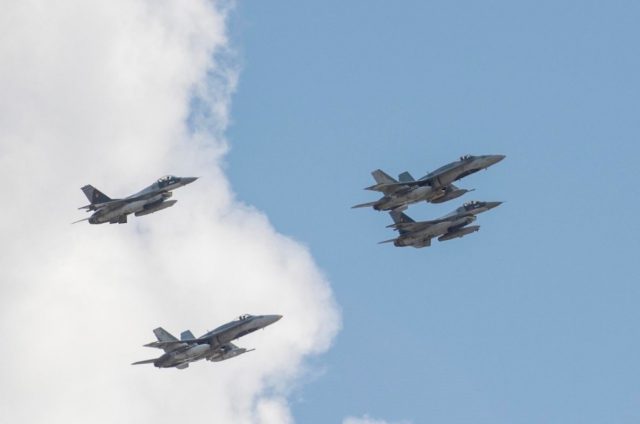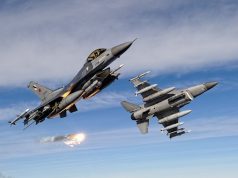
Royal Canadian Air Force CF-188 Hornet fighter jets have taken up their NATO air policing duties at Mihail Kogălniceanu Air Base and will be securing the skies alongside the Romanian Air Force for the coming four months.
A total of eight CF-18s have deployed to Romania. While the Canada’s Armed Force Air Task Force-Romania (ATF-R) conducts 24/7 air policing missions using a six aircraft rotation until December 2, 2022, two additional aircraft have been temporarily deployed for concurrent NATO training activities.
This is the seventh time that Canada has deployed an ATF to Romania on operation Reassurance since 2014.
During an official ceremony on August 4, marking the beginning of the CF-18 mission, Lieutenant General Fernando de la Cruz, Commander of NATO’s Combined Air Operations Centre (CAOC) Torrejón, Spain, presented the mission ready certificate to Lieutenant Colonel Stephan Latwaitis, ATF Detachment Commander.
Royal Canadian Air Force pilots from the 425th Squadron will fly quick reaction alert and training missions alongside Romanian fighter pilots. All missions are fully integrated into the Romanian defense system and NATO’s integrated air and missile defense system. Missions are controlled by the Control and Reporting Centre in Moara Vlăsiei, tactically commanded by the CAOC in Spain and overseen by NATO´s Allied Air Command in Germany.
“Ever since Russia’s initial invasion of Ukraine in 2014, Canada has been steadfast in demonstrating our commitment to NATO’s collective defense across Europe. Air surveillance and policing is a critical part of maintaining a nation’s security in the face of aggressive nations that continuously seek to test the defenses of their neighbors, something Canada has its own experience with in the Arctic. Our mission in Romania allows us to contribute to NATO’s collective defense, and allows us to deliver capabilities that are a tangible symbol of Canada’s resolve to NATO’s collective defense,” Canadian defense minister Anita Anand commented.
In another contribution to the international response to Russia’s invasion of Ukraine, the defense minister announced that Canada has authorized the deployment of Canadian Armed Forces personnel to train new recruits from the Armed Forces of Ukraine, as they seek to increase the size of their ground forces in the face of the Russian threat.
Under operation Unifier, Canada’s military training and capacity building mission in Ukraine, the CAF will deploy up to 225 personnel to the United Kingdom, the majority of whom will work as trainers, supported by a command and control element, for an initial deployment of approximately four months.
The first of up to three training cohorts, consisting of approximately 90 soldiers, will be largely drawn from 3rd Battalion Princess Patricia’s Canadian Light Infantry based out of Edmonton, Alberta. They are scheduled to depart on 12 August and will begin leading courses in the weeks’ following.
The first Canadian-led courses will take place at a military base located in South East England, and will teach a curriculum focused on individual skills required for frontline combat, including weapons handling, battlefield first aid, fieldcraft, patrol tactics and the Law of Armed Conflict.
Operation Unifier was launched in 2015 at the request of the Ukrainian government, and early this year, was expanded and extended until March 2025. Aspects of the mission were temporarily paused following the February 2022 full-scale invasion of Ukraine, with a commitment to resume training when and where conditions permitted.
Since February 2022, Canada has committed or delivered C$626 million in military assistance to Ukraine, including M777 howitzer artillery guns with replacement barrels and compatible ammunition, as well as specialized drone cameras and armored combat support vehicles, and associated training.


























